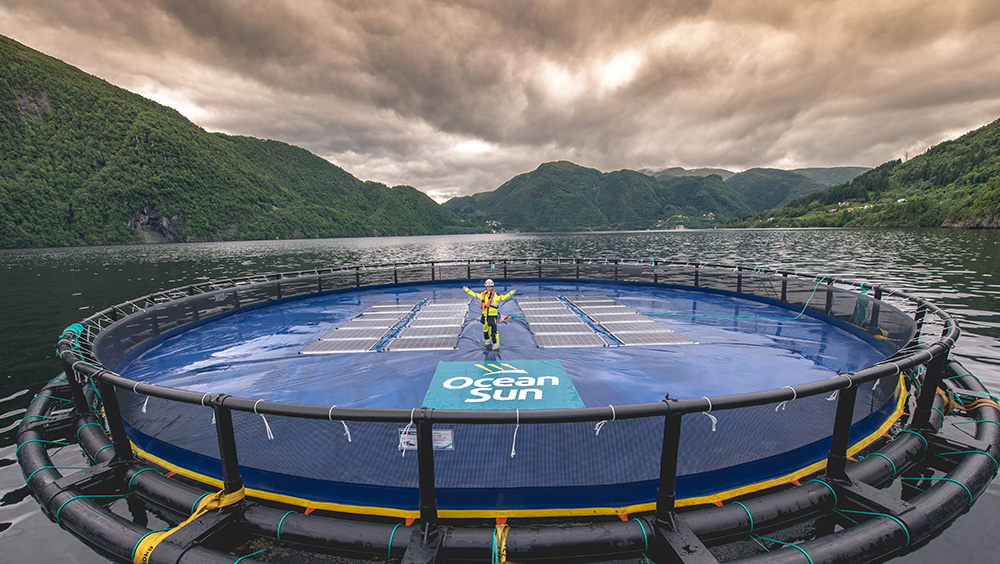This article appeared in the Norway-Asia Business Review. Click here to read the magazine.
With diverse terrain and large bodies of water, many parts of Southeast Asia aren’t suitable for traditional solar solutions. One firm believes it has found the solution to these challenges.
How do you get a person to walk on water? This may sound like a trick question, but it was something Ocean Sun needed to figure out during the development of its offshore floating solar solution. It was imperative for the Norwegian company to create special floating structures that were durable and easy for installers to work on.
Ocean Sun created a thin, polymer membrane that prevented the breaking of waves and salt-water intrusion while being sturdy enough to support silicon solar modules. However, trying to model how the membrane would perform in real life conditions proved to be challenging for the company’s leaders.
“The hydro-elastic performance of the membrane was hard to mathematically model. Very early, the conclusion from professors was that it needed to be built to see how it would perform,” Dr Børge Bjørneklett, Chief Technology Office at Ocean Sun detailed. “So, we decided to build a prototype and placed it in the fjords for a year. This allowed us to get a better idea of how it would hold up.”
The membrane provided a similar effect to that of oil on troubled water, according to Dr Bjørneklett. The prototypes ended up being successful even if the firm didn’t quite know what to expect.
“We were very surprised with the results. People were able to walk on this membrane that is only one millimetre thick,” Dr Bjørneklett said. “That is because of the surface tension, which completely changes with no breaking of waves. It was quite a sensation to view. When you look and see people walk on the membrane, it leaves quite an impression.”
This innovation was an important step in the development of Ocean Sun’s floating solar solution. It meant installation and maintenance of the solar panels could be completed quickly and safely.
“Having this ability to walk on the structure is important during installation. The solar modules need to be installed at a high speed,” Dr Bjørneklett added. “It was a big revelation to us when we saw how the membrane responded. We initially thought we would need to distribute the load, but this was not the case.”
While the technology behind the membrane is remarkable to see, the power generation behind offshore floating solar is what will make the difference. The technology allows for large-scale solar developments on oceans, lakes and reservoirs.
Ocean Sun looks to solve issues in Asia
Floating solar solves a few key problems with traditional solutions. While the renewable energy source will be extremely important, land-based generation options can be challenging, especially in places like Southeast Asia.
“The land area for traditional solar solutions is scarce. The land for the best solutions has already been taken,” Dr Bjørneklett said. “You need to open up new areas and new surfaces for solar power systems. Bodies of water are a good place for this.”
Research from the UN found that nearly half of the world’s population lives within 200 kilometres of coastline. Meanwhile, 20 of the world’s megacities, metropolitan areas with more than 10 million residents, are costal. Floating solar can benefit these areas.
For large cities, floating solar can be placed closer to cities than land-based solar power systems meaning less energy is lost during transport. Smaller cities in coastal areas, such as archipelagos, can also benefit from using the technology.
While many areas in places such as the Philippines and Indonesia don’t have a large enough land area for a solar plant, floating solar can provide them with a chance to utilise renewable energy. Many islands in Southeast Asia are still reliant on fossil fuel power generation which can be both expensive and harmful.
“The technology allows us to build for less cost than land-based solar and with a better yield thanks to the water cooling,” Dr Bjørneklett said. “When implemented it can give access to cheap, renewable energy to new parts of the globe where it may not currently be available such as Southeast Asia. In the archipelagos, it can be hard to create the space needed for land-based solar despite these areas wanting to utilise the energy source.”

Since the technology is not a one-size-fits-all solution, it can easily support a remote fishing village or a large city.
“The Ocean Sun solution allows for the usage of solar power on bodies of waters in a way that wasn’t possible in the past,” he stated. “The solution is also scalable. This means it can be used to provide sufficient renewable energy to different areas to suit all types of demands.”
In addition to the testing in Norway, the company has also set up a test bed on waters just off Pulau Ubin, an island in northeast Singapore. This is Ocean Sun’s benchmark study with air-cooled modules. It is the company’s first opportunity to see how the technology performs in equatorial waters. Areas in the lower latitudes reap the greatest benefits from floating solar technology.
“There is enormous interest in Ocean Sun all across the globe. The interest is everywhere plus or minus 40 degrees of the equator,” Dr Bjørneklett noted.
A cheaper, flexible alternative
Floating solar is a relatively new industry, but the progress has been impressive. Dr Bjørneklett, along with Ocean Sun Co-Founder Dr Øyvind Christian Rohn, started the company in 2016 to exploit Dr Bjørneklett’s patent application. Shortly after, Dr Arnt Emil Ingulstad made the first important investment and also joined the management team. Later they received a grant from Innovation Norway and together with a Norwegian industry consortium consisting of Bergen Kommunale Kraftselskap, Norsk Hydro, REC Solar, Lerøy Seafood and Grieg Seafood they were able to build the first prototype.
“I was in the photo voltaic business at REC Solar managing the design of the module. When REC Solar moved to Singapore in 2011, I left the company and went on to work in the oil and gas industry, building large hydro elastic structures stretching from the blow out preventor up to the floating rig used in ultra-deep-water drilling,” he explained.
These experiences have served Dr Bjørneklett well at Ocean Sun, Rohn also had experience with business administration in the oil and gas industry and the pair saw great potential for floating solar as an alternative to the oil sector in which they were working in.
“When we started Ocean Sun, there was almost no one else in the floating solar industry,” Dr Bjørneklett said. “I was most concerned about the cost on a dollar per watt basis. We tried to create the simplest and lowest cost solution to carry the solar PV panels in order to make it effective.”
Floating solar also has another key advantage when compared to land based generation. Since the panels are located on top of water, this provides natural cooling that makes production more efficient.
“The primary advantage of the Ocean Sun solution is the direct cooling of the solar PV panels,” Dr Bjørneklett stated. Another benefit is the total amount of polymers going into the structure. Our competitors aren’t able to match this.”
It is not just out at sea where Ocean Sun’s floating solar solution can be effective. The technology is also being touted as a way to improve efficiency at hydroelectric dams.
“Hydroelectric dams can suffer from water evaporation and this can be a problem. With the Ocean Sun solution, you can use solar power during the day and then switch turbines during the night to save potential energy,” Dr Bjørneklett pointed out.
The potential of Ocean Sun and floating solar could provide a massive boost to the renewable energy sector in Southeast Asia. At the moment, the company is focusing on its progress.
“We are looking to expand and continue to develop the product. We want to keep progressing the project and build larger demonstration units,” Dr Bjørneklett concluded. “We are up to six people now and are growing rapidly.”


































